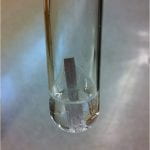DESCRIPTION:
When magnesium ribbon is placed in hydrochloric acid, hydrogen gas is produced causing the mixture to bubble.
Mg (s) + 2HCl (aq) → MgCl2 (aq) + H2 (g)
If they hydrogen gas is collected, it can be ignited to demonstrate the potential safety concerns of an evolved gas.
H2 (g) + O2 (g) → H2O (g)
TOPICS COVERED:
– chemical change
– combustion
– energy transformations
– evolution of a gas
– exothermic reactions
– light
– safety
– single replacement reactions
– synthesis reactions
MATERIALS NEEDED:
– 1M HCl (concentration does not need to be exact)
– 1 cm of Mg ribbon
– test tube
– small watch glass
– test tube rack or clamp & ring stand
– matches
PROCEDURE:
1. Clamp test tube to ring stand or place in rack
2. Add ~1mL of 1M HCl to test tube
3. Drop Mg ribbon in and cover with watch glass
4. Wait 30 seconds to a minute, remove watch glass, drop a lit match in the test tube (will make a loud “whoop”)
ADDITIONAL COMMENTS:
This is a demo that students love to do. It works well with types of reactions lessons.
SAFETY:
Safety goggles should be worn at all times. Hydrogen gas is explosive, special care should be taken.
REFERENCES:
Shakhashiri, B.Z. Chemical Demonstrations; University of Wisconsin Press: Madison, 1983; Vol. 1, pp 26.
This lesson plan‘s topic is reaction types. In this lesson, notes are presented using this PowerPoint then students use their notes to identify the types of reaction in a lab. Bubbling Magnesium is Reaction C in this lesson.
